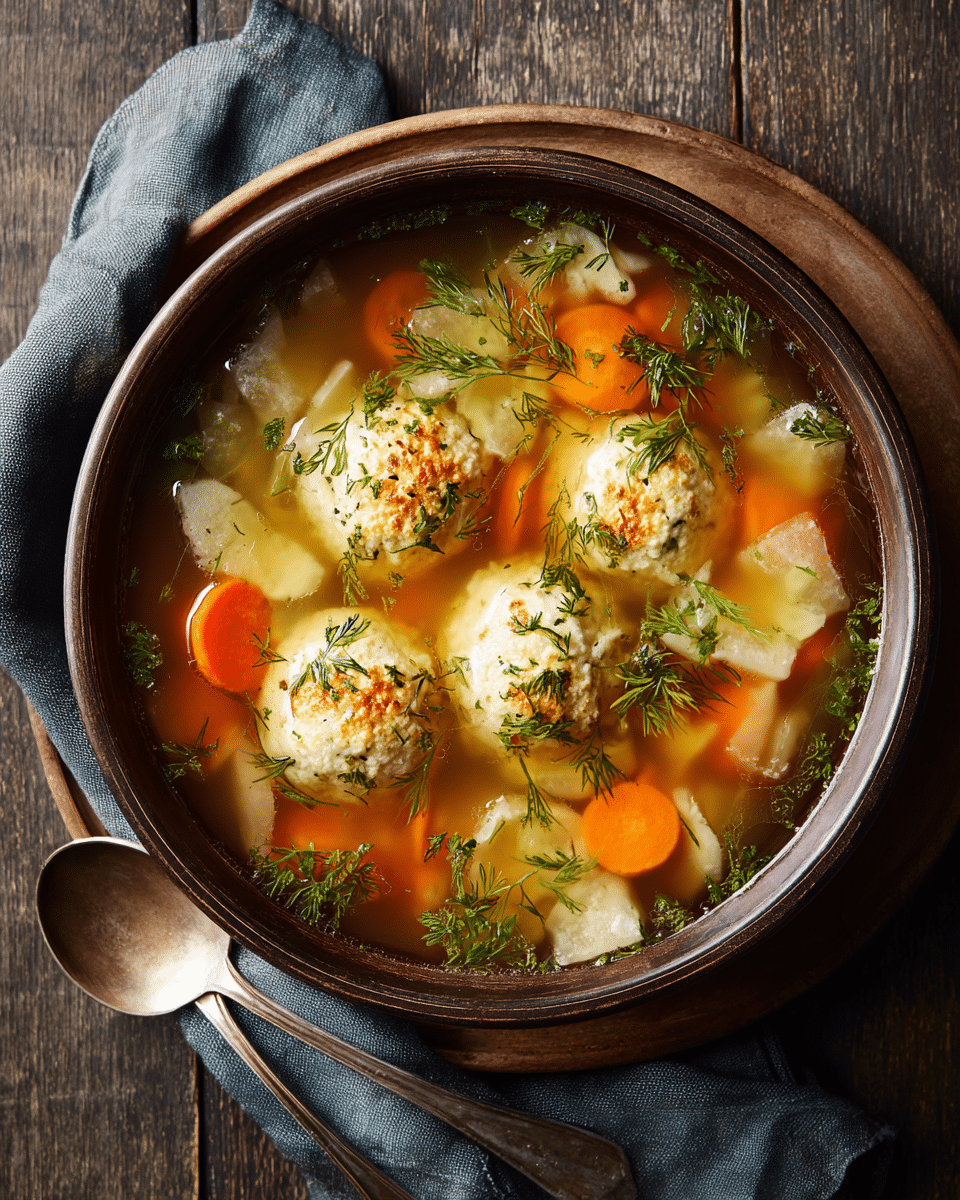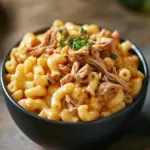Matzoh Ball Soup for Rosh Hashanah is a warm, comforting classic that symbolizes love, tradition, and togetherness. Fluffy, tender matzoh balls float in a rich, golden chicken broth infused with carrots, celery, onions, and fresh dill. This dish is more than just a soup it’s a heartfelt centerpiece for the holiday table, carrying the flavors and aromas that connect generations. Served as a starter for Rosh Hashanah, it offers both nourishment and the comforting promise of a sweet, prosperous new year.
Full Recipe
Ingredients:
-
1 whole chicken (about 4 pounds)
-
4 quarts water
-
3 carrots, peeled and chopped
-
3 celery stalks, chopped
-
2 medium onions, quartered
-
1 parsnip, peeled and chopped (optional)
-
1 bunch fresh dill, divided
-
Salt and freshly ground black pepper, to taste
For the Matzoh Balls:
-
1 cup matzoh meal
-
4 large eggs
-
1/4 cup chicken fat (schmaltz) or vegetable oil
-
1/4 cup water or chicken stock
-
1 teaspoon salt
-
1/2 teaspoon baking powder
Directions:
-
Place the chicken in a large stockpot and cover with 4 quarts of water. Bring to a boil over medium-high heat, skimming any foam that rises to the surface.
-
Add carrots, celery, onions, parsnip (if using), and half the dill. Reduce heat to a gentle simmer and cook for 1.5 to 2 hours, until the chicken is cooked through and the broth is rich in flavor.
-
Remove the chicken and vegetables from the pot. Strain the broth into another large pot, discarding solids or saving the chicken meat for serving.
-
To make the matzoh balls, in a medium bowl whisk eggs, schmaltz (or oil), water (or stock), salt, and baking powder. Stir in matzoh meal until combined. Cover and refrigerate for at least 30 minutes.
-
Bring a separate large pot of salted water to a gentle boil. With wet hands, form the matzoh mixture into 1-inch balls. Drop them into the boiling water, reduce to a simmer, and cook for 30–40 minutes until puffed and tender.
-
To serve, ladle hot chicken broth into bowls, add matzoh balls, and garnish with reserved fresh dill and chicken meat if desired. Season with salt and pepper to taste.
Prep Time: 30 minutes | Cooking Time: 2 hours 15 minutes | Total Time: 2 hours 45 minutes
Kcal: 320 kcal | Servings: 8 servings
Matzoh Ball Soup holds a cherished place in Jewish culinary tradition, and during Rosh Hashanah the Jewish New Year it takes on an even deeper meaning. The holiday is a time of reflection, renewal, and hope for a sweet year ahead. While many associate matzoh ball soup primarily with Passover, it is equally beloved during Rosh Hashanah and other Jewish celebrations. Its warm broth, fragrant herbs, and tender dumplings create a sense of comfort and togetherness, making it an ideal dish for ushering in a new year.
The Cultural Significance of Matzoh Ball Soup
Food is at the heart of Jewish holidays, and matzoh ball soup is more than just a first course it’s a bridge between generations. Traditionally made with a slow-simmered chicken broth and light, fluffy matzoh balls, this soup is a reminder of the wisdom and hospitality of those who came before us.
For Rosh Hashanah specifically, serving matzoh ball soup symbolizes warmth and blessing. The golden broth, shimmering with richness, reflects wishes for prosperity, while the round matzoh balls echo the cycle of the year and the continuity of life. It is the kind of dish that speaks without words, inviting everyone at the table to share in a moment of comfort and gratitude.
A Holiday of Symbolism and Flavor
Rosh Hashanah menus are rich in symbolism apples dipped in honey for sweetness, pomegranates for abundance, round challah for continuity and matzoh ball soup fits right into this tapestry. The use of fresh dill and herbs can symbolize growth and vitality, while the nurturing qualities of chicken broth speak to healing and restoration.
This soup is often served as part of a larger holiday meal that might include brisket, tzimmes (a sweet carrot and dried fruit stew), kugel, and honey cake. While each dish carries its own symbolic meaning, the matzoh ball soup often sets the tone, offering a warm welcome before the more robust courses arrive.
Variations Across Families and Regions
Just as no two families celebrate Rosh Hashanah in exactly the same way, there is no single “correct” version of matzoh ball soup. Some families prefer their matzoh balls light and airy, while others enjoy them dense and hearty. The broth can be a simple, clear chicken stock or enriched with vegetables, leeks, and parsnips for deeper complexity.
Ashkenazi Jewish traditions typically emphasize a golden, clarified broth, while Sephardic families may incorporate spices or different herbs for a unique twist. Modern interpretations sometimes swap chicken for turkey or even make a vegetarian version with a rich mushroom or vegetable stock, ensuring that everyone regardless of dietary needs can enjoy this holiday favorite.
The Science of Perfect Matzoh Balls
One of the most debated aspects of matzoh ball soup is texture. Some swear by the “floaters” approach, making matzoh balls that puff up light and delicate. Others prefer “sinkers,” denser dumplings that soak up more broth. The difference often comes down to the ratio of fat to matzoh meal, the resting time of the batter, and the cooking method.
For Rosh Hashanah, many cooks aim for a middle ground matzoh balls with enough structure to hold together in the broth, yet tender enough to break apart with a spoon. Schmaltz (rendered chicken fat) is traditional for richness, but vegetable oil can be used for a lighter flavor or to make the dish kosher for those serving meat and dairy separately.
Making it Ahead for the Holiday Rush
Rosh Hashanah dinners can involve a lot of cooking, so planning ahead for matzoh ball soup is a smart move. The broth can be made several days in advance and refrigerated, allowing any excess fat to solidify for easy removal. Matzoh balls can be cooked ahead of time and stored separately in the refrigerator or even frozen, then gently reheated in the broth just before serving.
This make-ahead approach not only saves time on the day of the holiday meal but also allows the flavors to develop fully. Many cooks insist that a chicken broth left to rest overnight takes on a richer, more cohesive flavor.
Serving and Presentation
Presentation matters, especially during a holiday meal where every dish is part of a larger celebratory table. For Rosh Hashanah, matzoh ball soup is often served in wide, shallow bowls that showcase the golden broth and fluffy dumplings. A sprig of fresh dill or parsley adds a bright visual touch, while a few pieces of tender chicken or seasonal vegetables give the bowl extra substance.
Some hosts like to serve individual bowls directly to each guest, while others prefer bringing a large tureen to the table, letting guests ladle their own portions a gesture that encourages sharing and conversation.
Pairing with Other Rosh Hashanah Dishes
Matzoh ball soup is typically the opening act in a multi-course Rosh Hashanah dinner. It pairs beautifully with crisp salads featuring seasonal apples and pomegranate seeds, roasted root vegetables, or sweet noodle kugel. Because it is light yet satisfying, it leaves room for the richer main courses to follow.
Drinks such as lightly sparkling apple cider, white wine, or herbal tea complement the flavors of the soup without overpowering it. For a complete holiday experience, many families follow the soup course with brisket, roasted chicken, or fish, and finish with honey cake or baklava for dessert.
Why Matzoh Ball Soup Endures Through the Generations
The enduring appeal of matzoh ball soup is as much about memory as it is about flavor. For many, it recalls childhood holiday meals, the sound of family chatter in the kitchen, and the comforting aroma of broth simmering on the stove. Passing down the recipe from one generation to the next is a way of preserving heritage and ensuring that family traditions remain alive.
Even in modern kitchens, where chefs experiment with fusion dishes and innovative plating, matzoh ball soup remains unchanged at its core. Its essence lies in hospitality, nourishment, and continuity values that resonate deeply during Rosh Hashanah.
Conclusion:
Matzoh ball soup is more than a delicious starter; it is a symbol of connection, tradition, and the hope that comes with a new year. Whether you make it exactly as your grandmother did or put your own modern twist on it, the act of preparing and sharing this dish during Rosh Hashanah is a meaningful way to honor the past while welcoming the future.
As the golden broth is ladled into bowls and the fluffy matzoh balls find their place, you are not just serving a soup you are offering comfort, love, and blessings for the year ahead. And in that simple, heartfelt gesture lies the true magic of Rosh Hashanah.






